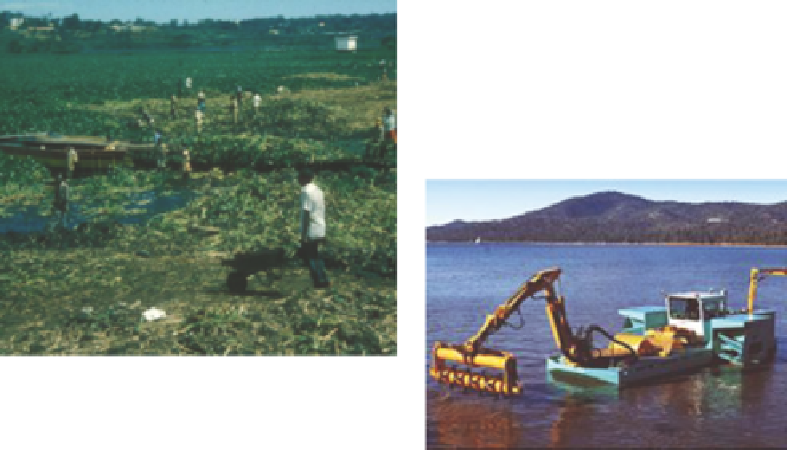Environmental Engineering Reference
In-Depth Information
Hand removal
Rotovation
FIGURE 17.11
Examples of mechanical removal. ((From Jacksonville District, Invasive species management,
n.d. Available at http://www.saj.usace.army.mil/Missions/Environmental/InvasiveSpecies/Management.aspx.)
2004). Winter drawdowns are most effective where the roots are exposed to periods of freezing and
thawing, while drawdown is generally ineffective for control in moist and mild climates where seep-
age keeps lake sediments moist (Cooke et al. 2005).
17.5.6 H
erbIcIdeS
Herbicides have commonly been used to either kill macrophytes or interrupt their growth pro-
cesses (Figure 17.12). Herbicides are typically applied to (Cooke et al. 2005) (1) eradicate exotic
species, (2) change plant community composition, or (3) treat excessive vegetative growth in
direct or high-use areas. As with the algicide copper sulfate, some of the herbicides have short-
term beneits but may introduce long-term harm. An example provided by Cooke et al. (2005)
was the prolonged use of sodium arsenate, where records of the Wisconsin Department of Natural
Resources between 1950 and when its use was discontinued in Wisconsin in 1970 indicated that
a total of 798,799 kg was added to 167 lakes (Lueschow 1972). Sodium arsenate was later deter-
mined to be a highly persistent hazardous material and according to the U.S. EPA TEACH sum-
mary (last revised in 2007), it is a known human carcinogen (cancer-causing agent).
A variety of herbicides are available and approved for use by the U.S. EPA for the control of
aquatic plants. These include (Cooke et al. 2005; Getsinger et al. 2011) 2,4-D, diquat, endothall, lu-
ridone, gylphosphate, and triclopyr. These herbicides vary by their mode of application and action.
Generally, chemicals with a similar chemical structure have similar actions, and control similar
FIGURE 17.12
Example of a herbicide application. (Courtesy of U.S. Army Corps of Engineers.)


Search WWH ::

Custom Search